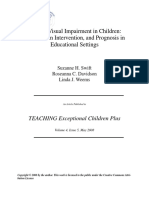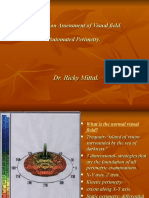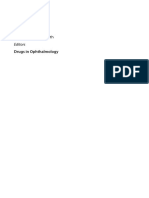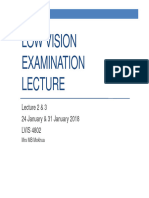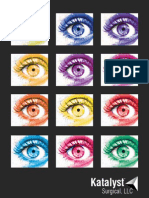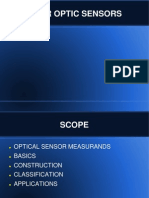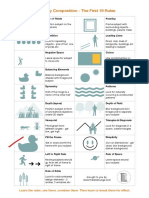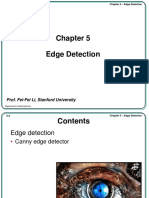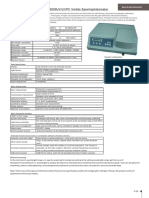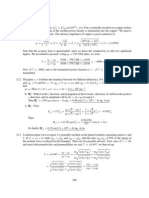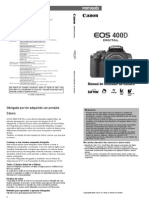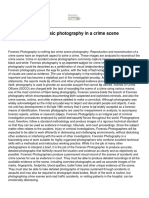Vision Screening - Dr. Wagner
Vision Screening - Dr. Wagner
Uploaded by
Dien Doan QuangCopyright:
Available Formats
Vision Screening - Dr. Wagner
Vision Screening - Dr. Wagner
Uploaded by
Dien Doan QuangOriginal Title
Copyright
Available Formats
Share this document
Did you find this document useful?
Is this content inappropriate?
Copyright:
Available Formats
Vision Screening - Dr. Wagner
Vision Screening - Dr. Wagner
Uploaded by
Dien Doan QuangCopyright:
Available Formats
Vision Screening
Rudolph S. Wagner, MD
Director of Pediatric Ophthalmology and
Strabismus
UMDNJ New Jersey Medical School
August 2010 - Vietnam
Visual Acuity Testing
In what age groups should it be done ?
How should it be done ?
What diseases and conditions are we looking for ?
What constitutes a failed test ?
What do we do once a problem is identified ?
Birth to Three Years
Ocular History
Vision assessment
External Inspection
Ocular Motility
Assessment
Pupil examination
Red reflex
Examination
Visual Acuity Measurement
3 Years of Age
Picture Charts (LEA, LH, Allen,)
5 years of age (Snellen letters, E game, HOTV
Charts on wall at 3m (10ft) Note: Distance Acuity !!
Measure Binocularly First
Record Acuity in Each Eye Independently
Attempt Ophthalmoscopy
Failed Visual Acuity Screening
Fewer than 4 of 6 correct in either eye on the 10/20
(20/40) or 3/6 (6/12)
Any two line difference between eyes
Avoid Crowding Phenomenon
LEA Symbols Blur to OOOO
Good-Lite 1155 Jansen
Farm Drive, Elgin, IL 60123
www.goodlite.com
www.richmondproducts.co
m/...
www.schoolhealth.com
I have no commercial
interest !
Measure Acuity in Each Eye
>
V
Examiner Must Control
The Exam !
Refraction: Pin Hole ?
Astigmatism
Hyperopia
Myopia
Sure Sight Autorefractor
Slit Lamp and Ophthalmoscope
Cataract Screening
Screening Pre-Verbal Children
Screening for a Red Reflex
Reduce Room Lights and Focus at meter with 0 lens and
largest diameter of light
http://aappolicy.aappublications.org (AAP) Policy
statement on Red Reflex Exam
Leukocoria or White Pupil
Blurred Vision
Cataracts: Not All Visually
Significant
Not Always Cataracts !
Poor Vision Following Cataract
Surgery
YAG Laser Capsulotomy
Vision screening for pre-verbal and beyond
86% of children entering 1
st
grade have had no eye exam
20-25% of children enter school with vision problems that can affect
their development and progress
70% of school-age children who have learning disability have some
form of visual impairment
95% of visions disorders can be corrected if detected early
The best defense is early detection
Vision Assessment
Evaluate ability to fix and follow objects
Try cover/uncover test
Observe for Nystagmus
Developmental milestones: Smile to face (6 - 8 weeks)
, follow objects (3months)
Get the Child Happy and
Interested
Cover Each Eye and Observe Fixation and
Reaction to Occlusion
Left Eye Covered Right Eye Covered
Teller Acuity Cards
Assess visual acuity in
infants
Labor intensive
procedure!
Mostly used in
research studies
Photo Screening
Polaroid Instant
Photograph
Refractive Errors
Strabismus or Squint
Check aap.org
American Academy of
Pediatrics
AMERICAN ACADEMY OF PEDIATRICS
Use of Photoscreening for Childrens Vision Screening
PEDIATRICS Vol. 109 No. 3 March 2002, pp. 524-52
Use of Photoscreening for Childrens Vision Screening
This statement asserts that all children should be screened
for risk factors associated with amblyopia. Guidelines are
suggested
for the use of photoscreening as a technique for
the detection
of amblyopia and strabismus in children of
various age groups.
The American Academy of Pediatrics
favors additional research
of the efficacy and cost-
effectiveness of photoscreening as
a vision screening tool.
PediaVision PlusOptix S04
The PediaVision solution assists in the detection of :
Refractive errors
Amblyopia
Strabismus
Anisocoria
Central Media Opacities
Confidential
30
http://www.pediavision.com/
Pediavision Instant Screening Results
32
Pass/Refer results are user defined
and based on the following:
Near-sightedness (myopia)
Far-sightedness (hyperopia)
Unequal refractive power
(anisometropia)
Blurred vision, eye structure
problem (astigmatism)
Pupil size deviations (anisocoria)
The PediaVision Solution
The measuring principle is based on eccentric photo-retinoscopy.
Infrared light is projected through the pupil onto the retina.
Depending on the refractive error the reflected light forms a specific
brightness pattern within the pupil. The spherical refraction is
calculated based on this crescent pattern. To determine cylinder
and axis, the same measurement is repeated in three meridians.
Please refer to the Technical Information module for more specific
information on screening results.
PediaVision PlusOptix S04
The fully automated solution conducts:
a comprehensive refractive assessment
analyzes the pupil size
creates a gaze deviation chart
uses advanced digital imaging for quick reference
of more advanced issues
Field Testing of the PlusOPtix
S04
Arthur et al. AAPOS abstract 2008
94% agreement camera and exam
Sensitivity 83% Specificity 96%
Positive predictive value 74%
Only 1% untestable rate
Vision Screening: Anyone can
do it !
You might also like
- Examination Techniques and Cases For Final MRCOphthDocument157 pagesExamination Techniques and Cases For Final MRCOphthshrub1n92No ratings yet
- Farukh's Practical OphthalmologyDocument30 pagesFarukh's Practical OphthalmologyMuhammad Usman Ghani GormaniNo ratings yet
- Case Reviews in Ophthalmology Expert Consult - OnlDocument2 pagesCase Reviews in Ophthalmology Expert Consult - Onldr. mostakNo ratings yet
- OptoPrep Part1 StudyCalendar 6-Month PDFDocument7 pagesOptoPrep Part1 StudyCalendar 6-Month PDFmelanieNo ratings yet
- Panduan JKR LightingDocument29 pagesPanduan JKR Lightinggolet2016100% (7)
- Case Study PediatricDocument7 pagesCase Study PediatricJoshua Havana100% (2)
- Optometric ManagementDocument4 pagesOptometric Managementirijoa100% (1)
- Low VisionDocument36 pagesLow VisionDanang Bagus UntoroNo ratings yet
- Astigmatism - Optics Physiology and ManagementDocument318 pagesAstigmatism - Optics Physiology and ManagementJosepMolinsReixach100% (4)
- Drugs & Ophthalmology CCDocument16 pagesDrugs & Ophthalmology CCbahaashakirNo ratings yet
- Examination of Eye PT IIDocument77 pagesExamination of Eye PT IIMihaela TomaNo ratings yet
- Eye ExamDocument12 pagesEye ExamQing Liang OngNo ratings yet
- HypermetropiaDocument42 pagesHypermetropiaMalik AllahbachayaNo ratings yet
- Current Management of Childhood Amblyopia: Shin Hae ParkDocument12 pagesCurrent Management of Childhood Amblyopia: Shin Hae ParkSyarifah Thalita NabillaNo ratings yet
- Optometry's Role As A Primary Health Care Provider in Managed CareDocument13 pagesOptometry's Role As A Primary Health Care Provider in Managed CareANDREW OMAKANo ratings yet
- 06 AccommodationDocument12 pages06 AccommodationMwanja MosesNo ratings yet
- 1-CR History TakingDocument4 pages1-CR History TakingNishan AryalNo ratings yet
- Dynamic RetinosDocument6 pagesDynamic RetinosguybarnettNo ratings yet
- OKAP International User Guide 2014Document9 pagesOKAP International User Guide 2014MiminNo ratings yet
- Case 1 Anisometropia Phs Usa PDFDocument10 pagesCase 1 Anisometropia Phs Usa PDFZuhud Zinedine PangindraNo ratings yet
- History Taking& Examination of Eye: Mohamed Ahmed El - ShafieDocument38 pagesHistory Taking& Examination of Eye: Mohamed Ahmed El - ShafiesandeepNo ratings yet
- Low Vision PrinciplesDocument272 pagesLow Vision Principlesmariam mhNo ratings yet
- Myopia PresentationDocument18 pagesMyopia PresentationEevaeNo ratings yet
- Case Study Contact LensDocument1 pageCase Study Contact Lens2020847412No ratings yet
- HypermetropiaDocument9 pagesHypermetropiaHana SetianingsihNo ratings yet
- AmblyopiaDocument11 pagesAmblyopiaNimas PritaNo ratings yet
- TrachomaDocument27 pagesTrachomaGangadhar DungaNo ratings yet
- Direct OphthalmoscopeDocument16 pagesDirect OphthalmoscopeMuhammed AbdulmajeedNo ratings yet
- Schirmer TestDocument3 pagesSchirmer TestRisa UtamiNo ratings yet
- 13.10.10-Eyelid and Adnexal Disease 2, PPT Presentasi 23 Okt 2009Document51 pages13.10.10-Eyelid and Adnexal Disease 2, PPT Presentasi 23 Okt 2009Ronald Ariyanto Wiradirnata0% (1)
- AAO 2015 Atropine For Myopia DR Donald Tan 11-16-15 RedactedDocument15 pagesAAO 2015 Atropine For Myopia DR Donald Tan 11-16-15 RedactedunonounoNo ratings yet
- Eye ExaminationDocument23 pagesEye Examinationcynthia167No ratings yet
- Contact Applanation TonometryDocument6 pagesContact Applanation TonometryAmirhosseinSamadzadehNo ratings yet
- Physiology of EyeDocument55 pagesPhysiology of EyeAyesha KhatunNo ratings yet
- AstigmatismDocument47 pagesAstigmatismDiana PhiriNo ratings yet
- Lecture V PresbyopiaDocument17 pagesLecture V PresbyopiaHenok BirukNo ratings yet
- CPG 5Document29 pagesCPG 5Budio SatyaNo ratings yet
- History Taking: Practical 1 InstructionDocument12 pagesHistory Taking: Practical 1 InstructionDimsyafelNo ratings yet
- Cortical BlindnessDocument14 pagesCortical BlindnessAmal Almutiri100% (1)
- Pterygium Ambreen ppt1Document87 pagesPterygium Ambreen ppt1Syeda F AmbreenNo ratings yet
- Common Eye Problems and DiagnosisDocument84 pagesCommon Eye Problems and Diagnosisvivekrajbhilai5850No ratings yet
- The Eye Guide Physical ExamDocument85 pagesThe Eye Guide Physical Examtrisna minNo ratings yet
- Anomalies of ConvergenceDocument12 pagesAnomalies of ConvergenceDaniDenzongpaSulaemanNo ratings yet
- Childhood Cataract A Socio-Clinical Study at A Public Sector Tertiary Eye Care Centre in IndiaDocument7 pagesChildhood Cataract A Socio-Clinical Study at A Public Sector Tertiary Eye Care Centre in IndiaInternational Journal of Innovative Science and Research TechnologyNo ratings yet
- VFA Visual Field AssessmentDocument51 pagesVFA Visual Field AssessmentsightbdNo ratings yet
- Management of Juvenile Glaucoma With TrabeculectomyDocument147 pagesManagement of Juvenile Glaucoma With TrabeculectomyErlinaerlin100% (1)
- The CoverDocument4 pagesThe CoverDaniDenzongpaSulaeman100% (1)
- XXXDocument134 pagesXXXrhlzuraNo ratings yet
- Questionnaire Survey Bases Awareness and Knowledge of Glaucoma Among Adult Patient in Rural and Urban Area in RaipurDocument3 pagesQuestionnaire Survey Bases Awareness and Knowledge of Glaucoma Among Adult Patient in Rural and Urban Area in RaipurInternational Journal of Innovative Science and Research TechnologyNo ratings yet
- Anisometropia in Children and Its ProblemDocument37 pagesAnisometropia in Children and Its ProblemekaNo ratings yet
- Drugs of OphthalmologyDocument9 pagesDrugs of OphthalmologyPutri KartiniNo ratings yet
- Best Aid To Ophthalmology - Pramod TK - 318Document3 pagesBest Aid To Ophthalmology - Pramod TK - 318Danielle SangalangNo ratings yet
- School Eye Screening and The National Program For Control of Blindness - 2Document6 pagesSchool Eye Screening and The National Program For Control of Blindness - 2rendyjiwonoNo ratings yet
- Esotropia and ExotropiaDocument49 pagesEsotropia and ExotropiaEdoga Chima Emmanuel100% (1)
- Low Vision Examination Lecture 2.pptx-2018Document89 pagesLow Vision Examination Lecture 2.pptx-2018willemlrouxNo ratings yet
- Visual AcuityDocument30 pagesVisual AcuityNestor Agustin AlberdiNo ratings yet
- Dynamic RetinosDocument4 pagesDynamic Retinoscastorswag100% (1)
- Ophthalmology Clinical Cases pixOpOpDocument61 pagesOphthalmology Clinical Cases pixOpOpUsman ImtiazNo ratings yet
- Astigmatism, A Simple Guide To The Condition, Diagnosis, Treatment And Related ConditionsFrom EverandAstigmatism, A Simple Guide To The Condition, Diagnosis, Treatment And Related ConditionsNo ratings yet
- Simplifying Strabismus: A Practical Approach to Diagnosis and ManagementFrom EverandSimplifying Strabismus: A Practical Approach to Diagnosis and ManagementNo ratings yet
- Bai Giang CT So NaoDocument10 pagesBai Giang CT So NaoDien Doan QuangNo ratings yet
- 2012 Katalyst Surgical Catalog PDFDocument69 pages2012 Katalyst Surgical Catalog PDFDien Doan QuangNo ratings yet
- Lueck Ptosis (Text Only)Document25 pagesLueck Ptosis (Text Only)Dien Doan QuangNo ratings yet
- A and V Pattern and Overaction of ObliqueDocument12 pagesA and V Pattern and Overaction of ObliqueDien Doan QuangNo ratings yet
- Bionic Eye WrittenDocument53 pagesBionic Eye WrittenDien Doan QuangNo ratings yet
- Unit 1 AQA Physics - WavesDocument2 pagesUnit 1 AQA Physics - WavesAlex KingstonNo ratings yet
- POLARIZATIONDocument54 pagesPOLARIZATIONfunkpatel123No ratings yet
- Physics High Weightage ChaptersDocument4 pagesPhysics High Weightage ChaptersSheetal KulkarniNo ratings yet
- OFSDocument18 pagesOFSRakesh KumarNo ratings yet
- University of Pune: Photography AND Audio Visual Production (V)Document15 pagesUniversity of Pune: Photography AND Audio Visual Production (V)vinurNo ratings yet
- Composition - Rules SummaryDocument1 pageComposition - Rules SummaryNi ViNo ratings yet
- 6.1.2 Optical Network Elements - VIDocument32 pages6.1.2 Optical Network Elements - VIpavitraNo ratings yet
- Edge Detection: Prof. Fei-Fei Li, Stanford UniversityDocument35 pagesEdge Detection: Prof. Fei-Fei Li, Stanford Universitypham tamNo ratings yet
- Objetive and QuestionairDocument13 pagesObjetive and QuestionairMithin YuviNo ratings yet
- Class 8 - 10th Sept20222Document32 pagesClass 8 - 10th Sept20222Muttu PattarNo ratings yet
- SP 2000UV UVPC BrochureDocument1 pageSP 2000UV UVPC BrochureSecreto SecretoNo ratings yet
- OPTHA 1.2 BASIC EYE EXAM - Dr. CheongDocument4 pagesOPTHA 1.2 BASIC EYE EXAM - Dr. CheongPatricia ManaliliNo ratings yet
- Chapter 4-Lighting Design and Applications (2)Document26 pagesChapter 4-Lighting Design and Applications (2)Pratheek H BNo ratings yet
- Chapter 6Document136 pagesChapter 6vinothNo ratings yet
- Datasheet - V3DX3-010BR21A - 1126983 - Es ENGLIShDocument9 pagesDatasheet - V3DX3-010BR21A - 1126983 - Es ENGLIShAlexander GarCia'No ratings yet
- Biliogy End of Year 9Document4 pagesBiliogy End of Year 9point-vacuous-0tNo ratings yet
- PrinciplesRemoteSensing PDFDocument591 pagesPrinciplesRemoteSensing PDFMawicho MjrNo ratings yet
- Fastconnect Field-Installable Connectors: Parameter ValueDocument2 pagesFastconnect Field-Installable Connectors: Parameter ValueTourchianNo ratings yet
- S10 Q2 Week-6Document5 pagesS10 Q2 Week-6Aiphrell Anne D. MoradaNo ratings yet
- Standa Optics 2012Document60 pagesStanda Optics 2012behru1No ratings yet
- DocumentDocument3 pagesDocumentpandem soniyaNo ratings yet
- ILCA-77M2 4DFOCUS Camera Settings GuideDocument18 pagesILCA-77M2 4DFOCUS Camera Settings GuideRichard UrbanNo ratings yet
- Chap 12Document13 pagesChap 12api-3702256100% (4)
- Dispersionscattering of LightDocument26 pagesDispersionscattering of LightAngelo EbreoNo ratings yet
- Canon EOS 400DDocument178 pagesCanon EOS 400DThiago IgarashiNo ratings yet
- MILLIMETER WAVE COMMUNICATION May 23Document9 pagesMILLIMETER WAVE COMMUNICATION May 23Sushmitha ThulasimaniNo ratings yet
- Iare NDT Lecture NotesDocument103 pagesIare NDT Lecture Notesnagarajan224100% (1)
- Importance of Forensic Photography in A Crime Scene InvestigationDocument4 pagesImportance of Forensic Photography in A Crime Scene InvestigationSophia Nadine MauricioNo ratings yet
- Effects of Thin Film Thickness On Emittance, Reflectance and Transmittance of Nano Scale MultilayersDocument5 pagesEffects of Thin Film Thickness On Emittance, Reflectance and Transmittance of Nano Scale MultilayersVivek BelaNo ratings yet







































